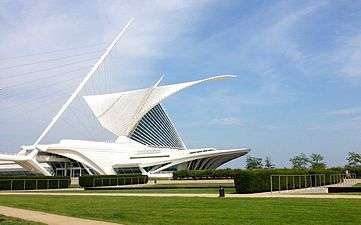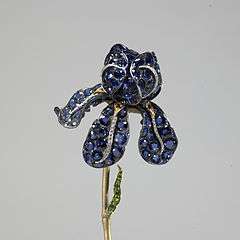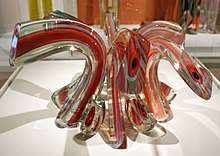Milwaukee Art Museum
The Milwaukee Art Museum (MAM) is an art museum in Milwaukee, Wisconsin. Its collection contains nearly 25,000 works of art.[1] It is one of the largest museums in the United States.[2]
 Milwaukee Art Museum from south-west | |

| |
| Established | 1882 |
|---|---|
| Location | 700 N. Art Museum Drive Milwaukee, Wisconsin |
| Coordinates | 43.0393°N 87.8971°W |
| Type | Art museum |
| Visitors | 400,000+ |
| Director |
|
| Website | www |
History

Origins

Beginning around 1872, multiple organizations were founded in order to bring an art gallery to Milwaukee, as the city was still a growing port town with little or no facilities to hold major art exhibitions. Over the span of at least nine years, all attempts to build a major art gallery had failed. Shortly after that year, Alexander Mitchell donated all of his collection to constructing Milwaukee's first permanent art gallery in the city's history.[3]
In 1888, the Milwaukee Art Association was created by a group of German panorama artists and local businessmen. The same year, British-born businessman Frederick Layton built, endowed and provided artwork for the Layton Art Gallery, now demolished. In 1911, the Milwaukee Art Institute, another building constructed to hold other exhibitions and collections, was completed, adjacent to the Layton Art Gallery.
The Milwaukee Art Museum was founded in 1888 and is purported to be Milwaukee's first art gallery. That claim is disputed by the Layton Art Gallery, which opened the same year.[4]
The Milwaukee Art Center, now the Milwaukee Art Museum, was formed when the Milwaukee Art Institute and Layton Art Gallery merged their collections in 1957 and moved into the newly built Eero Saarinen-designed Milwaukee County War Memorial.
Kahler and Calatrava Buildings
In the latter half of the 20th century, the museum came to include the War Memorial Center in 1957 as well as the brutalist Kahler Building (1975) designed by David Kahler and the Quadracci Pavilion (2001) created by Spanish architect Santiago Calatrava.
The Quadracci Pavilion contains a movable, wing-like brise soleil that opens up for a wingspan of 217 feet (66 m) during the day, folding over the tall, arched structure at night or during inclement weather. The pavilion received the 2004 Outstanding Structure Award from the International Association for Bridge and Structural Engineering.[5] This iconic building, often referred to as "the Calatrava", is used in the museum logo.
.jpg) The Reiman Bridge provides pedestrian access to downtown Milwaukee
The Reiman Bridge provides pedestrian access to downtown Milwaukee Milwaukee Art Museum with the Brise Soleil closed
Milwaukee Art Museum with the Brise Soleil closed.jpg) Central vestibule of the Milwaukee Art Museum
Central vestibule of the Milwaukee Art Museum
2015 Shields Building
In November 2015, the museum opened a $34 million expansion funded jointly by a museum capital campaign and by Milwaukee County.[6] The new building, the Shields Building, designed by Milwaukee architect James Shields of HGA, provides an additional 30,000 square feet for art, including a section devoted to light-based media, photography, and video installation.[7] The building includes a new atrium and lakefront-facing entry point for visitors and was designed with cantilevered elements and concrete columns to complement, respectively, the existing Calatrava and Kahler structures on the site.[8] The final design emerged after a lengthy process that included the main architect's departure because of design disputes and his return to the project.[9]
Collection
The museum houses nearly 25,000 works of art housed on four floors, with works from antiquity to the present. Included in the collection are 15th- to 20th-century European and 17th- to 20th-century American paintings, sculpture, prints, drawings, decorative arts, photographs, and folk and self-taught art. Among the best in the collection are the museum's holding of American decorative arts, German Expressionism, folk and Haitian art, and American art after 1960.[10][11][12]
The museum holds one of the largest collections of works by Wisconsin native Georgia O'Keeffe.[13][14][15] Other artists represented include Gustave Caillebotte, Nardo di Cione, Francisco de Zurbarán, Jean-Honoré Fragonard, Winslow Homer, Auguste Rodin, Edgar Degas, Claude Monet, Gabriele Munter, Henri de Toulouse-Lautrec, Frank Lloyd Wright, Pablo Picasso, Joan Miró, Wassily Kandinsky, Mark Rothko, Robert Gober, and Andy Warhol.
It also has paintings by European painters Francesco Botticini, Jan Swart van Groningen, Ferdinand Bol, Jan van Goyen, Hendrick Van Vliet, Franz von Lenbach (Bavarian Girl), Ferdinand Waldmüller (Interruption), Carl Spitzweg, Bouguereau, Gerome (2 Majesties), Gustave Caillebotte, Camille Pissarro, Alfred Kowalski (Winter in Russia), Jules Bastien-Lepage (The Wood Gatherer), and Max Pechstein.[16][17][18][19][20][21][22][23][24][25]
_with_Two_Birds_-_Walters_44297.jpg) Ukrainian - Temple Pendant (Kolt) with Two Birds
Ukrainian - Temple Pendant (Kolt) with Two Birds Tiffany and Company - Iris Corsage Ornament
Tiffany and Company - Iris Corsage Ornament.jpg) A wrecked car installed on a pole near the museum, taken off view in spring of 2017
A wrecked car installed on a pole near the museum, taken off view in spring of 2017
- Campbell's Soup Cans by Andy Warhol, 1965.
 Harvey K. littleton, lemon-red crown, 1989
Harvey K. littleton, lemon-red crown, 1989_02_riflessi_sull'acqua.jpg) Claude Monet, Waterloo bridge, 1900
Claude Monet, Waterloo bridge, 1900 Frank Lloyd Wright, "Tree of Life" Window from the Darwin D. Martin House (Buffalo, New York), 1904
Frank Lloyd Wright, "Tree of Life" Window from the Darwin D. Martin House (Buffalo, New York), 1904 Gustave Caillebotte, Boating on the Yerres, 1877.
Gustave Caillebotte, Boating on the Yerres, 1877.
Management
From 2002 to 2008, the director and CEO was David Gordon.[28]
As of 2015, the museum’s endowment is around $65 million.[29] Endowment proceeds cover a fraction of the museum's expenses, leaving it overly dependent on funds from day-to-day operations such as ticket sales.[30] Daniel Keegan, who has served as the museum's director since 2008, negotiated an agreement with Milwaukee County and the Milwaukee County War Memorial for the long-term management and funding of the facilities in 2013.[31]
Controversy
In June 2015 the museum's display of a work depicting Benedict XVI created outrage among Catholics and others.[32]
See also
- Argo, a sculpture on the grounds
- The Calling, a sculpture in the Museum's collection on adjacent O'Donnell Park
References
- "Collections". www.mam.org. Retrieved 2016-08-04.
- Bruce Murphy (15 April 2014). "Why the Milwaukee Art Museum Changed Its Design". Urban Milwaukee. Retrieved 16 June 2018.
- Conrad, Howard Lewis (1895). History of Milwaukee County: From Its First Settlement to the Year 1895, Volume 2. Milwaukee, WI: American Biographical Publishing Company. pp. 88–90.
- Barry Adams (29 November 2015). "On Wisconsin: Like its director, the Milwaukee Art Museum is transformed". Wisconsin State Journal. Retrieved 17 June 2017.
- "Milwaukee Art Museum Addition, Milwaukee, Wisconsin". International Association for Bridge and Structural Engineering. Archived from the original on February 28, 2018. Retrieved January 31, 2018.
- Kilmer, Graham (16 November 2015). "Milwaukee Art Museum Unveils New Addition". Urban Milwaukee. Retrieved 24 November 2015.
- "New Building Opens at Milwaukee Art Museum". New York Times. 23 November 2015. Retrieved 24 November 2015.
- Schumacher, Maey Louise. "Milwaukee Art Museum's new lakefront atrium a gracious, rugged success". Milwaukee Journal-Sentinel. Retrieved 24 November 2015.
- Murphy, Bruce (17 November 2015). "Still Controversy Over Art Museum Addition". Urban Milwaukee. Retrieved 24 November 2015.
- Sarah Hauer (17 February 2017). "Art museum's Haitian collection explores spirituality, history, daily life". Milwaukee Journal-Sentinel. Retrieved 16 June 2018.
- "Milwaukee Art Museum". Atlas Obscura. Retrieved 16 June 2018.
- Chris Foran (19 October 2016). "Dark shadows overtake Milwaukee Art Museum". Milwaukee Journal-Sentinel. Retrieved 16 June 2018.
- Kate Silver (9 August 2017). "Things to do in Milwaukee". Washington Post. Retrieved 16 June 2018.
- Mary Bergin (6 December 2015). "Milwaukee Art Museum gets new look with $34 million overhaul". Eau Claire Leader-Telegram. Retrieved 16 June 2018.
- Amy Bertrand (22 October 2017). "Milwaukee: More than just beer here". St. Louis Post-Dispatch. Retrieved 16 June 2018.
- Goldstein, Rosalie (1986). Guide to the permanent collection. Milwaukee: The Museum. p. 248.
- "Triptych with Josiah and the Book of the Law, The Adoration of the Golden Calf and The Transfiguration of Christ and by anonymous artist of the 16th century Netherlands". RDK. 9 November 2015. Retrieved 28 June 2018.
- D'Alessandro, Stephanie (2003). German Expressionist Prints: The Marcia Granvil Specks Collection. Milwaukee: Hudson Hills Press. p. 11. ISBN 0-944110-94-0.
- The Bulletin of the Cleveland Museum of Art. Cleveland: Cleveland Museum of Art. 1994. p. 15.
- Mary Louis Schumacher (21 April 2014). "Milwaukee Public Library may sell famous 'Bookworm' painting by Carl Spitzweg". Milwaukee Journal-Sentinel. Retrieved 28 June 2018.
- Lardinois, A. P. M. H. (2006). Land of Dreams: Greek and Latin Studies in Honour of A.H.M. Kessels. Michigan: Brill. p. 248. ISBN 9789004150614.
- Cass, Jeff (2008). Romantic Border Crossings. Hampshire: Ashgate Publishing Ltd. ISBN 978-0-7546-6051-4.
- Brodskaïa, Nathalia (2018). Gustave Caillebotte (1848-1894).
- Sharp, William (1914), The Bay View Magazine, Volume 22, Detroit, MI: Bay View Reading Circle, p. 352
- Morrison, John (2014). Painting Labour in Scotland and Europe, 1850-1900. London: Ashgate Publishing. ISBN 9781472415196.
- "The Flag". Smithsonian Institution Research Information System. Retrieved January 16, 2017.
- "The Flag". Milwaukee Art Museum. Retrieved January 16, 2017.
- "Milwaukee Art Museum | Pressroom". Mam.org. 2007-02-19. Retrieved 2017-01-06.
- Ted Loos (December 28, 2015), Milwaukee Art Museum Reinvigorates With Renovations New York Times.
- Mary Louise Schumacher (October 28, 2011), Milwaukee Art Museum expansion began under Bowman Milwaukee Journal Sentinel.
- Mary Louise Schumacher (October 23, 2015), Dan Keegan to leave Milwaukee Art Museum in May Milwaukee Journal Sentinel.
- Johnson, Annysa (2015-06-29). "Milwaukee Art Museum's embrace of condom portrait of pope draws disgust". Jsonline.com. Retrieved 2017-01-06.
External links
| Wikimedia Commons has media related to Milwaukee Art Museum. |